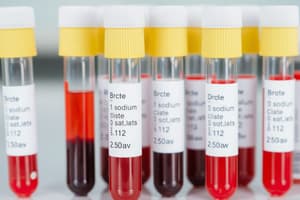Podcast
Questions and Answers
Why is it crucial to consider the patient's condition before collecting blood for hemostasis testing?
Why is it crucial to consider the patient's condition before collecting blood for hemostasis testing?
- The presence of certain medications will change the required blood to anticoagulant ratio.
- The integrity of the specimen is highly sensitive to various patient-related factors. (correct)
- The patient's diet can affect the stability of coagulation factors.
- The patient's age may affect the choice of anticoagulant.
What is the primary purpose of buffering the sodium citrate used as an anticoagulant in hemostasis testing?
What is the primary purpose of buffering the sodium citrate used as an anticoagulant in hemostasis testing?
- To maintain the pH within the tube, preserving labile factors. (correct)
- To enhance the anticoagulant properties of the citrate.
- To prevent the activation of platelets during blood collection.
- To inhibit the effects of heparin in patients undergoing heparin therapy.
Which of the following specimens is MOST suitable for assessing platelet adhesion and aggregation properties?
Which of the following specimens is MOST suitable for assessing platelet adhesion and aggregation properties?
- Whole blood
- Platelet-rich plasma (PRP) (correct)
- Platelet-poor plasma (PPP)
- Serum
When performing whole blood aggregometry, under which condition is it necessary to dilute the whole blood sample with saline?
When performing whole blood aggregometry, under which condition is it necessary to dilute the whole blood sample with saline?
In light transmittance aggregometry (LTA), which type of specimen is typically used?
In light transmittance aggregometry (LTA), which type of specimen is typically used?
What is the primary concern associated with using EDTA (ethylenediaminetetraacetic acid) as an anticoagulant in hematology?
What is the primary concern associated with using EDTA (ethylenediaminetetraacetic acid) as an anticoagulant in hematology?
If a laboratory cannot process platelet samples within 3 hours of collection, what is the MOST appropriate course of action?
If a laboratory cannot process platelet samples within 3 hours of collection, what is the MOST appropriate course of action?
Why is it important to avoid over-centrifugation of light blue top tubes?
Why is it important to avoid over-centrifugation of light blue top tubes?
What effect do aspirin and NSAIDs have on hemostasis?
What effect do aspirin and NSAIDs have on hemostasis?
Why is the first 3 mL of blood typically discarded in hemostasis testing when using the ETS method?
Why is the first 3 mL of blood typically discarded in hemostasis testing when using the ETS method?
What is the consequence of a 'short draw' in blood collection for coagulation testing?
What is the consequence of a 'short draw' in blood collection for coagulation testing?
Why should a phlebotomist avoid prolonged tourniquet application during blood collection for coagulation studies?
Why should a phlebotomist avoid prolonged tourniquet application during blood collection for coagulation studies?
What type of needle is generally recommended for hemostasis testing in adults with good veins, using the evacuated tube system?
What type of needle is generally recommended for hemostasis testing in adults with good veins, using the evacuated tube system?
Under what circumstance is it necessary to adjust the sodium citrate volume in blood collection for coagulation testing?
Under what circumstance is it necessary to adjust the sodium citrate volume in blood collection for coagulation testing?
Why is EDTA not used for coagulation testing?
Why is EDTA not used for coagulation testing?
In hemostasis specimen storage, what is the MOST important temperature consideration?
In hemostasis specimen storage, what is the MOST important temperature consideration?
Whole blood samples for platelet aggregometry should NOT be refrigerated because chilling:
Whole blood samples for platelet aggregometry should NOT be refrigerated because chilling:
What causes shortened clotting times in oxalated samples?
What causes shortened clotting times in oxalated samples?
What does detection of Visible hemolysis in hemostasis plasma samples imply?
What does detection of Visible hemolysis in hemostasis plasma samples imply?
What is the MOST accurate description of the appearance of PRP?
What is the MOST accurate description of the appearance of PRP?
Flashcards
Common Sample
Common Sample
Venous whole blood is the most common sample.
Anticoagulant
Anticoagulant
- 2% buffered sodium citrate is the anticoagulant used in a 9:1 ratio.
Sodium Citrate functions
Sodium Citrate functions
Sodium citrate acts as a buffering agent, preserving factors V & VIII and best for platelet aggregation.
Whole Blood Aggregometry
Whole Blood Aggregometry
Signup and view all the flashcards
Light Transmittance Aggregometry
Light Transmittance Aggregometry
Signup and view all the flashcards
Platelet Counting
Platelet Counting
Signup and view all the flashcards
Platelet Function test
Platelet Function test
Signup and view all the flashcards
Clot-Based Tests
Clot-Based Tests
Signup and view all the flashcards
Patient Preparation
Patient Preparation
Signup and view all the flashcards
Smoking Effect
Smoking Effect
Signup and view all the flashcards
Aspirin and NSAIDS affecting...
Aspirin and NSAIDS affecting...
Signup and view all the flashcards
Warfarin effect
Warfarin effect
Signup and view all the flashcards
Preferred Collection Tube
Preferred Collection Tube
Signup and view all the flashcards
Discard Volume
Discard Volume
Signup and view all the flashcards
Excess anticoagulant
Excess anticoagulant
Signup and view all the flashcards
Clotted specimens
Clotted specimens
Signup and view all the flashcards
Effects of Hemolysis
Effects of Hemolysis
Signup and view all the flashcards
Blood Stasis
Blood Stasis
Signup and view all the flashcards
Storage Temperatures
Storage Temperatures
Signup and view all the flashcards
Adjustments
Adjustments
Signup and view all the flashcards
Study Notes
- The general rule for blood collection using sodium citrate is to analyze the sample within 2 hours.
Hemostasis Specimen Collection and Handling
- Hemostasis laboratory procedures use venous whole blood.
- 3.2% buffered sodium citrate is an anticoagulant with a 9:1 ratio to blood.
- Venous whole blood is the most common sample.
- Sodium citrate acts as a buffering agent and is preferred for patients undergoing Heparin Therapy.
- Sodium citrate preserves factor V and Factor VIII and is satisfactory in platelet aggregation.
- The sodium citrate to blood ratio is 1:9.
- Light blue top tubes usually hold 2.7 mL of blood with 0.3 mL being anticoagulant.
Specimens Used in Testing
- Whole blood is used for platelet aggregometry and platelet count.
- Platelet rich plasma (PRP) is used for platelet aggregometry and platelet function tests.
- Platelet-poor plasma (PPP) is used for coagulation testing/assays
- PPP is the most common specimen used for Hemostasis.
Whole Blood Aggregometry
- Uses whole blood diluted 1:1 with saline without centrifugation
- Dilution applies if platelet count is >100,000; no dilution if <100,000
- Electrical Impedance/ Electrical Resistance used as principle (RBC, WBC, & PLT, resists electricity).
- Light Transmittance Aggregometry uses PRP and is more common, along with WBA, for platelet aggregometry.
Platelet Lumiaggregometry
-
Detects aggregation activity and ability to secrete granules using whole blood or PRP.
-
Luminescence is the principle.
-
Whole blood is used for Platelet counting as well as EDTA (Lavender) for CBC or Sodium Citrate (Light blue) for Coagulation testing
-
EDTA problem: causes RBC shrinkage theoretically.
-
Platelet Function Tests use PRP to determine platelet quality, not using PPP
-
Tests that use PRP include Platelet Adhesion/Retention Testing or Glass Bead Retention Test along with EDTA or Heparin.
-
Platelet Aggregation Test is used and is tested using Platelet Factor 3 Availability
-
Platelet Factor 4 & Beta-Thromboglobulin requires centrifugation at ref. temp. and uses CTAD as anticoagulant
-
Latex D-dimer Assay uses EDTA, heparin, or sodium citrate as an anticoagulant.
-
Platelets are most responsive 30 minutes to 3 hours post-collection.
-
If not processed within 3 hours, refrigeration is possible, but can activate Factor VII and XI, causing platelet aggregation or vWF precipitation.
-
Freezing is an alternative (-20C for two weeks, -70C for over two weeks) when sample cannot be processed within those hours.
-
PPP specimens are centrifuged and separated and is used to detect activity within secondary Hemostasis.
-
PPP is platelet-poor to avoid bias when assessing secondary hemostasis with false shortened results.
-
Clot-Based Tests like PT, APTT, Thrombin-clotting time, and Reptilase time use PPP to assess fibrin clot formation speed.
-
Light blue top specimens should not be stirred or disturbed post-centrifugation, potentially causing false shortened results from lysed RBCs.
Summary of Tests for Each Specimen:
- Whole Blood:
- Whole Blood Aggregometry
- Platelet Lumiaggregometry
- Platelet Count
- PRP:
- Light Transmittance Aggregometry
- Platelet Lumiaggregometry
- Platelet Function Test
- Platelet Adhesion/ Retention Testing or Glass Bead Retention Test
- Platelet Aggregation Test
- Platelet Factor 3 Availability Test
- Platelet Factor 4 & Beta-Thromboglobulin
- PPP:
- Clot-Based Tests:
- PT
- APTT
- Thrombin-clotting time
- Reptilase time
- CT/BT
- Clot-Based Tests:
Patient Management During Hemostasis Specimen Collection
- Patients need not fast, but should avoid vigorous activities and rest quietly for 30 minutes before hemostasis testing.
- Patient must not be tired or out-of breath; it is necessary to avoiding nicotine and exercise
- Patient avoids caffeine, garlic, ginger, Vit. K supplements and St. John's wort (Antidepressant).
- Avoid Aspirin, NSAIDS, Oral Contraceptive pills for collection.
- Nicotine raises blood pressure, avoid substances that increase blood pressure.
- Aspirin and NSAIDs affect platelet aggregation, impacting primary hemostasis.
- Long term Mefenamic acid usage leads to ulcer and chronic blood loss causing low MCV.
- Patients with anxiety patients that take St. John's Wort(Antidepressant) leads to increased activity of Warfarin as well as high fibrinogen groups in patients taking contraceptive pills.
- Scurvy (Vit. C Deficiency) leads to Petechiae (purpura) after tourniquet application
- Vitamin C is crucial for hemostasis via blood vessel integrity.
Drugs That Affect Testing:
- Aspirin: impairs platelet function and stops cyclooxygenase to stop thromboxane A2
- Coumadin (warfarin): inhibits Factors IX, X, VII, II, Protein S, C, Z (prolongs PT)
- Heparin: Clotting factors prolonged causes prolonged APTT
- Penicillin: causes changes of blood vessel walls and induces hemolysis
- Warfarin inhibits Vit. K dependent group and Factor VII is affected, so PT determines amount of Warfarin intake.
- Warfarin is converted to a metabolite post digestive tract.
- Heparin given intravenously or subcutaneously and is preferred.
- Penicillin causes platelet dysfunction (Ex. Beta-lactams antibiotics, Broad-spectrum antibiotics)
Collection Tubes:
- Light blue top, plastic-coated tubes are preferred.
- Most hemostasis specimens are collected in plastic blue-stopper (blue-top, blue-closure) sterile evacuated blood collection tubes containing a measured volume of 0.105 to 0.109 M (3.2%) buffered sodium citrate anticoagulant
- Tubes of uncoated soda-lime glass are unsuitable they activate platelets and the plasma
- Siliconized (plastic-coated) glass tubes are available, but their use is waning because of concern for potential breakage, with consequent risk of exposure to blood borne pathogens
Important Note:
- Plastic, polystyrene, silicone coated glass syringes used for hemostasis testing.
- Evacuated tube system (ETS) is the preferred collection method.
Specimen Collection Protocol
- The evacuated blood collection tube system (ETS) is the preferred method
- Syringe collection with initial "discard tubes" needed when necessary
- In venipuncture, the order of draw is collection of discard first, followed in the second draw
- Hemostasis testing discards 3mL blood because of Tissue thromboplastin (Factor III). In ETS, a 3 mL discard tube is used before a light blue top.
- Non-additive tube (cleansing of tissue thromboplastin; can be used for serum tests)
- Light blue top tube
- EDTA
- Plastic syringe (additional platelet tests)
Important Note:
- The phlebotomist may use and discard a preliminary blue-topped tube if non-additive tubes are unavailable,.
Blood to Anticoagulant Ratio (9:1)
- Short draw generates prolonged clot-based coagulation due to excess anticoagulant neutralizes the calcium in test reagents
- Excess anticoagulant prolongs PT and APTT
- Reject and recollect short draws because saturation does not occur
- Overfilled samples cause false shortened results.
Important Note:
- A sample with a Ratio ay ↑9 (ex. 10:1) gives false shortened results
- A sample with a Ratio ay ↓9 (ex. 8:1) gives false prolonged results
Clotted Specimens:
Are useless for hemostasis testing and require inversion to avoid clot formation
- Always reject clotted specimens when the tube inversion step is skipped after donation
- Excessive Specimen Agitation causes hemolysis; requires a phlebotomist to shake the tube
- Hemolysis releases procoagulants ADP to create clot formations
- Excess Needle Manipulation causes procoagulant substances from outside the skin to activate coagulation
- Traumatic venipuncture causes falsely shortened and unreliable clotting time tests
Important Note:
Traumatic Venipuncture releases tissue thromboplastin to the extrinsic pathways of coagulation; the tourniquet should be released within 1 minute
- A tourniquet may cause Stasis, slowing down venous flow and accumulating coagulation factor VIII and von Willebrand factor (VWF), which may result in false shortening of clot-based coagulation test results
- Stasis occurs as a result of prolonged the tourniquet for blood flow reasons and causes Factor VII, Factor VIII, Factor XII and vWF concentration
- Tourniquet application prevents stasis and requires observation of blood flow for vein selection
- It's not possible to do Catch methods as IV. lines can be caught. If the IV line causes catching, discard 6mL.
Table 42-1 Hemostasis Specimen Collection Errors
-
Errors requiring new collection includes: - Short Draw: volume of blood used is 90% less. -Clot in Specimen: centrifuge; the presence of even a small clot requires that the specimen be recollected, so use for visuals - Causes Hemolysis: creates activations that indicate platelets and coagulation results Visible Hemolysis generates pink or red plasma in vitro - Generates Lipemia or Icterus: practitioners must employ a mechanical instrument. If tools are not able to measure clots due to highly colored specimens.
- Causes Prolonged Tourniquet application: the concentration of von Willebrand factor and factor VIII elevate to decease parameters. Stasis occurs
- Generates Specimen temperature causing destroyed integrity V and VII factors and triggers Willybrand multimers at 1-6 degrees C.
- Storage at above generates storage: deteriorates coagulation Standards
-
Needle bores prevents hemolysis and activation of platelets
-
Large Specimens (25mL) require 19 g Needle usage
-
Children require 23g needles to minimize vein pressure
-
High hematocrit creates adjustments due to decreased volume of plasma with high anticoagulant
-
adjustment is used after hematocrit exceeds 55%
Important Notes:
Ethylenediaminetetraacetic Acid (EDTA) is irreversible from binding so coagulation must never used. Inhibits thrombin from reacting and Is useful to collect blood count as well as testing for Molecular.
- Use for the platelet to bind and test
- CTAD stops coagulation and activates specialized assays
- Specimens with prothrombin require 20-21 Gauge needle/ standard
- Gauge requires small samples for tests and Gauge 19 to retrieve clots -
- 23 G Is for patients that are very hard Other Anticoagulants: Test for specialized factors that has problems clotting.
SpecimenStorage Timeand Temperatures must stored in
- 18 - C to 24 C
Important Notes:
Must be in sealed sealed tube for longer periods in low temperature
- Cannot be heated; always in temperature
- Cold temperature increase V and XI
Important Notes Table:
- 4 h or 24 h after PT and PTT without fractions added to specimens.
- 18 - or 3h after
Preparation for Specimen Assay:
- Use for 3.2% Sodium citrated
- Whole Bloods must have clots
- Samples 200 uL in the centrifuge
- 150 gx for 11 to 15 mins to produce
Studying That Suits You
Use AI to generate personalized quizzes and flashcards to suit your learning preferences.




